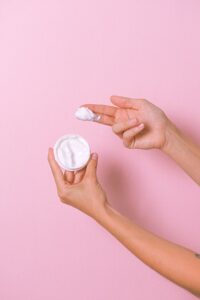How to Exfoliate for Smoother, Softer Skin

If you’re dealing with rough, dry skin on your body, exfoliation can be a game-changer. Exfoliating can help remove dead skin cells, promote cell turnover, and reveal smoother, softer skin. However, it’s important to know how to exfoliate properly to avoid damaging your skin. In this blog post, we’ll explore the best ways to exfoliate your body for smoother, softer skin.
Choose the Right Exfoliant
There are two main types of exfoliants: physical and chemical. Physical exfoliants include scrubs, brushes, and loofahs, while chemical exfoliants include acids like alpha-hydroxy acid (AHA) and beta-hydroxy acid (BHA). Both types of exfoliants can be effective, but it’s important to choose the right one for your skin type.
If you have sensitive skin, you may want to avoid physical exfoliants and opt for a gentler chemical exfoliant like lactic acid or PHA. If you have oily or acne-prone skin, you may benefit from a BHA like salicylic acid. If you’re not sure which type of exfoliant to use, consult with a dermatologist or esthetician.
Exfoliate Regularly
Exfoliating once or twice a week is typically sufficient for most people. However, if you have very dry or rough skin, you may benefit from exfoliating more frequently. It’s important not to overdo it, as excessive exfoliation can damage your skin and lead to irritation and inflammation.

Be Gentle
When exfoliating, it’s important to be gentle and avoid applying too much pressure. Scrubbing too vigorously can cause micro-tears in your skin, which can lead to irritation and inflammation. Use light, circular motions when exfoliating, and avoid scrubbing the same area for too long.
Focus on Rough Areas
Pay special attention to rough areas like your elbows, knees, and feet when exfoliating. These areas tend to be more prone to dryness and roughness, and can benefit from more frequent exfoliation. You can also use a pumice stone or foot file to help remove rough skin from your feet.
Moisturize After Exfoliating
After exfoliating, it’s important to moisturize your skin to help lock in hydration and prevent dryness. Use a rich, hydrating moisturizer like shea butter or cocoa butter to nourish your skin and promote softness.
Don’t Exfoliate Sunburned or Irritated Skin
If you have sunburned or irritated skin, it’s best to avoid exfoliating until your skin has fully healed. Exfoliating can further irritate your skin and delay the healing process.
Consider Professional Exfoliation
If you’re looking for more intensive exfoliation, consider getting a professional treatment like a body peel or microdermabrasion. These treatments use stronger exfoliants and can help promote smoother, softer skin. However, they should only be performed by a licensed esthetician or dermatologist.

In conclusion, exfoliation can be a great way to combat rough, dry skin and promote smoother, softer skin. However, it’s important to choose the right exfoliant for your skin type, be gentle when exfoliating, and moisturize after exfoliating to prevent dryness. By following these tips, you can achieve the smooth, soft skin you’ve always wanted.

